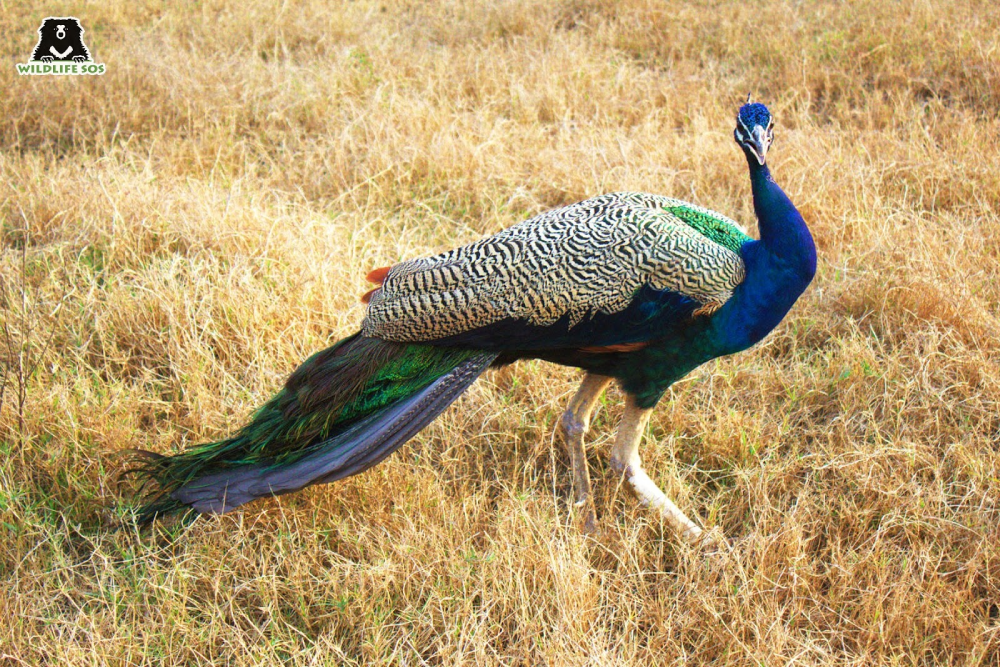Physical Characteristics
The Indian Peafowl exhibits a marked sexual dimorphism, with males (peacocks) being more visually striking than females (peahens). Male peafowls boast a spectacular train, which is not actually the tail but elongated upper tail coverts. These coverts are adorned with eye-catching “eyespot” patterns in hues of blue, green, and gold. The train can reach up to 2 meters in length, accounting for more than 60% of the bird’s total body length.
The peacock’s head, neck, and breast are covered in iridescent blue feathers. In contrast, the peahen has a more subdued coloration, with brown and grey feathers that provide camouflage, essential for nesting and protecting chicks. Both sexes have a fan-shaped crest on their heads, but the peacock’s crest is more prominent and vibrant.

Habitat and Distribution
Indian Peafowl are native to the Indian subcontinent, including India, Sri Lanka, Nepal, Bhutan, and Pakistan. They thrive in a variety of habitats, from dense forests and scrublands to farmland and urban gardens. These birds are highly adaptable and can live in both dry and moist environments.
Peafowls prefer areas with dense undergrowth where they can take cover from predators and open spaces where males can display their plumage during the breeding season. They are commonly found in national parks and wildlife sanctuaries across India, such as Ranthambore, Gir, and Keoladeo Ghana.
Behavior and Diet
Indian Peafowls are omnivores with a diet that includes a mix of plant material, insects, and small animals. They forage on the ground, scratching the soil to uncover seeds, grains, berries, and insects. They have also been known to hunt small reptiles and rodents.
These birds are known for their loud calls, especially during the breeding season. The peacock’s call is a loud “meow” or “may-awe,” which can be heard over long distances. This call serves multiple purposes, including attracting mates and warning of predators.
Breeding and Reproduction
The breeding season of the Indian Peafowl typically coincides with the monsoon season, from April to September. During this time, male peafowls engage in elaborate courtship displays to attract females. The peacock fans out his train in a spectacular display, shaking it to create a rustling sound while he struts and calls.
Peahens choose their mates based on the size, color, and condition of the peacock’s train, as these are indicators of genetic fitness. After mating, the female lays a clutch of 4-8 eggs in a shallow nest on the ground. The peahen alone incubates the eggs and takes care of the chicks once they hatch. The chicks are precocial and can follow their mother soon after hatching, although they remain dependent on her for protection and guidance for several weeks.
Cultural Significance
The Indian Peafowl holds a prominent place in Indian culture and mythology. It is associated with various deities in Hinduism, most notably Lord Krishna and Goddess Saraswati. Lord Krishna is often depicted with a peacock feather in his crown, symbolizing beauty and cosmic significance. The peacock is also the vehicle (vahana) of Saraswati, the goddess of knowledge and wisdom, representing grace and purity.
The bird has also found its way into Indian art, folklore, and traditions. Peacocks are often featured in traditional Indian textiles, paintings, and architecture. The peacock throne of the Mughal emperors, a legendary seat of gold encrusted with jewels and adorned with peacock motifs, epitomizes the opulence and artistic excellence of its time.
Conservation Status
Despite their cultural significance and legal protection, Indian Peafowl face several threats, including habitat loss, hunting, and poisoning. However, they are currently listed as “Least Concern” by the International Union for Conservation of Nature (IUCN) due to their widespread distribution and large population.
Conservation efforts in India include legal protection under the Wildlife Protection Act of 1972, which prohibits hunting and trade of peafowls. Additionally, various wildlife sanctuaries and national parks provide safe habitats for these birds. Community-based conservation programs and awareness campaigns are also crucial in preserving the Indian Peafowl and its habitat.
Conclusion
The Indian Peafowl is a symbol of the splendor and diversity of India’s natural world. Its striking beauty, cultural importance, and ecological role make it a species worth cherishing and protecting. As we continue to balance development with conservation, the Indian Peafowl stands as a reminder of the rich natural heritage that must be preserved for future generations.









